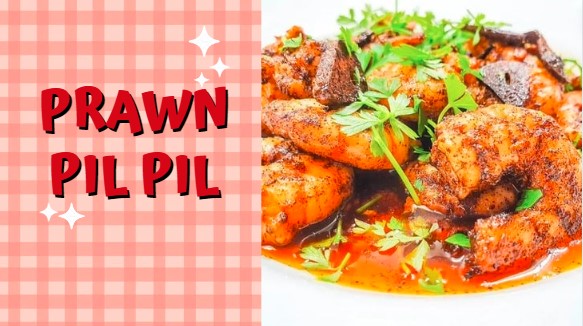Thai cuisine is celebrated globally for its vibrant flavors and delicate balance of sweet, sour, salty, and spicy elements. Among the culinary delights it offers, Thai appetizers are particularly noteworthy for their diversity and the experience they bring to the palate, setting the stage for the main courses.
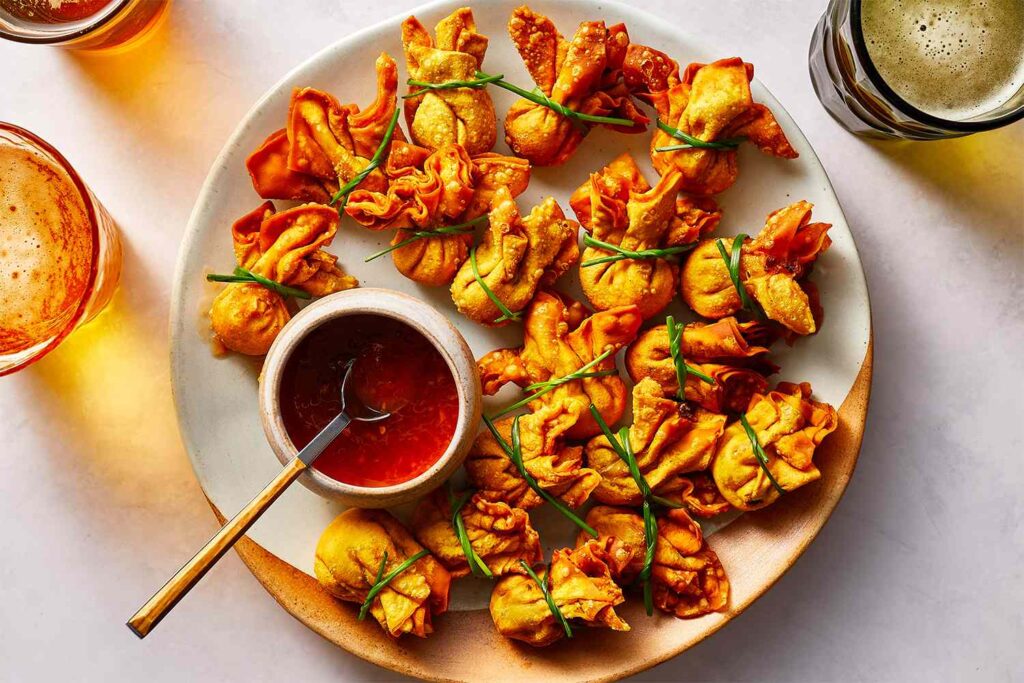
Thai appetizers often serve as a showcase of the country’s abundant natural resources, including fresh herbs, vegetables, and seafood. These starter dishes are not only meant to stimulate the appetite but also to introduce diners to the broad spectrum of flavors that Thai cuisine has to offer.
A popular Thai appetizer is the “Satay” – skewers of marinated meat grilled to perfection and served with a rich, creamy peanut sauce. Another favorite is “Spring Rolls,” crisp wrappers filled with a mixture of vegetables, noodles, and sometimes meat, served with a sweet and spicy dipping sauce. “Miang Kham,” a traditional snack, involves wrapping bits of lime, roasted peanuts, chili, and dried shrimp in betel leaves, offering a burst of flavor in every bite.
These appetizers are typically light, encouraging diners to anticipate the varied and flavorful dishes yet to come. Each appetizer is a small testament to Thai culinary art, inviting everyone to explore further into its delightful gastronomy. Must add these appetizers in your Thai Food Menu.
Delicious Thai Appetizers
Tod Mun Pla (Thai Fish Cakes)
Tod Mun Pla, a beloved Thai appetizer, consists of deep-fried fish cakes made from finely ground fish mixed with red curry paste and finely sliced kaffir lime leaves. This mixture is seasoned with fish sauce and a hint of sugar to enhance its flavor.
These patties are skillfully fried until golden and crisp on the outside while remaining tender inside. Served with a refreshing cucumber relish and a sweet and spicy dipping sauce, Tod Mun Pla offers a delightful introduction to Thai flavors.
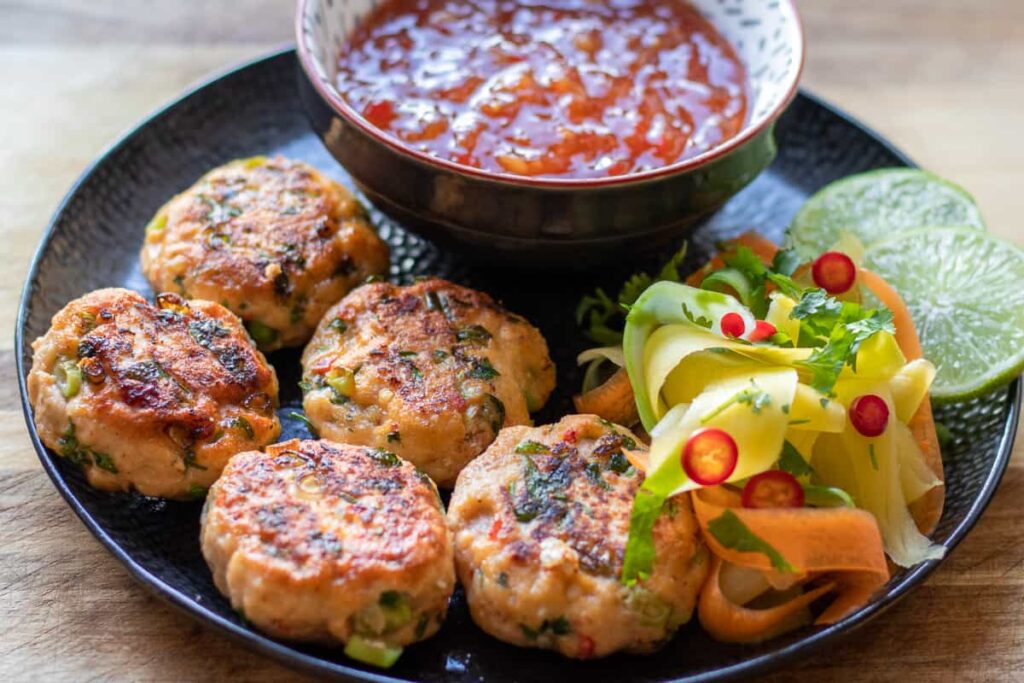
Ingredients for Tod Mun Pla
- 500 grams of white fish fillets (such as cod or tilapia), finely minced
- 2 tablespoons red curry paste
- 1 egg, beaten
- 1 tablespoon fish sauce
- 1 teaspoon sugar
- 6 kaffir lime leaves, finely sliced
- Vegetable oil, for frying
- For the Cucumber Relish
- 1/2 cucumber, diced
- 1 small red onion, thinly sliced
- 1/4 cup white vinegar
- 2 tablespoons sugar
- 1/4 cup water
- 1 teaspoon salt
- 1 small chili, sliced (optional)
Instructions for Tod Mun Pla
Prepare the Fish Mixture: Begin by placing the minced fish in a large bowl. Add the red curry paste, beaten egg, fish sauce, and sugar to the bowl. Mix thoroughly until the ingredients are well combined and the mixture is smooth. Fold in the finely sliced kaffir lime leaves.
Shape the Cakes: With moist hands, take portions of the fish mixture and form them into small patties, about half an inch thick.
Fry the Fish Cakes: Heat a generous amount of vegetable oil in a frying pan over medium heat. Once hot, carefully add the fish cakes. Fry them for about 2-3 minutes on each side or until they are golden brown and cooked through. Remove the fish cakes from the oil and drain them on paper towels.
Make the Cucumber Relish: Combine vinegar, sugar, water, and salt in a small saucepan. Bring to a boil, then remove from heat. Let the mixture cool. Once cool, add the diced cucumber, sliced red onion, and chili (if using). Stir well to combine.
Serve: Serve the warm fish cakes with the cool cucumber relish and enjoy the delightful contrasts of flavors and textures.
Laab Gai (Spicy Chicken Salad)
Laab Gai is a vibrant and spicy Thai salad made with finely chopped or ground chicken. It’s a harmonious blend of fresh herbs like mint, cilantro, and shallots, with a zesty dressing of lime juice, fish sauce, and roasted ground rice that adds a nutty texture.
Chili flakes give it a fiery kick. This dish is typically enjoyed with a side of fresh vegetables and sticky rice, embodying the essence of Thai cuisine with its fresh, bold, and aromatic flavors.

Ingredients for Laab Gai
Instructions for Laab Gai
Cook the Chicken: In a skillet, cook the ground chicken over medium heat until fully cooked. Break the chicken into small pieces as it cooks to ensure even cooking and a fine texture. Drain any excess liquid to keep the salad from becoming soggy.
Prepare the Dressing: In a small bowl, combine the fish sauce, lime juice, and sugar. Stir until the sugar is dissolved. This mixture will be the dressing that adds the tangy and umami flavors to the salad.
Mix the Salad: Transfer the cooked chicken to a mixing bowl. While still warm, pour the dressing over the chicken. Add the roasted rice powder and chili flakes, and mix well to coat the chicken evenly.
Add Fresh Herbs and Shallots: Add the sliced shallots, mint leaves, cilantro, and spring onion to the chicken. Toss everything together until the ingredients are well distributed throughout the salad.
Serve: Serve the Laab Gai immediately to enjoy its freshness. It’s traditionally accompanied by fresh vegetables and sticky rice. The vegetables offer a crisp contrast to the spicy and flavorful chicken, making it a refreshing and satisfying meal.
Yum Woon Sen (Spicy Glass Noodle Salad)
Yum Woon Sen is a refreshing Thai salad known for its light yet flavorful profile. It combines glass noodles made from mung beans with a mix of shrimp and minced pork, often enhanced with tomatoes, onions, and celery.
The salad is dressed in a tantalizing sauce of lime juice, fish sauce, and chili peppers, delivering a spicy kick. Fresh cilantro and sometimes mint top off the dish, offering a herbal freshness that complements the tangy and spicy flavors beautifully.

Ingredients for Yum Woon Sen
Instructions for Yum Woon Sen
Prepare the Glass Noodles: Soak the glass noodles in warm water until they are soft, which usually takes about 10 minutes. Once soft, drain and cut them into manageable lengths. Set aside.
Cook the Meats: Bring a pot of water to a boil and add the shrimp. Cook until they are pink and opaque, about 2-3 minutes. Remove the shrimp and set aside. In the same boiling water, cook the minced pork until fully cooked. Drain and set aside with the shrimp.
Make the Dressing: In a small bowl, mix together the fish sauce, lime juice, sugar, and chili flakes. Adjust the flavors according to taste, balancing the salty, sour, and spicy components.
Combine the Salad: In a large mixing bowl, combine the prepped glass noodles, cooked shrimp, cooked minced pork, tomato wedges, sliced onion, and chopped celery. Pour the dressing over the salad and toss thoroughly to combine all the ingredients.
Add Herbs and Serve: Sprinkle chopped cilantro and mint leaves (if using) over the salad. Toss lightly to distribute the herbs throughout the salad. Serve the Yum Woon Sen chilled or at room temperature to enjoy its full burst of flavors.
Khanom Pang Na Moo(Pork Toast)
Khanom Pang Na Moo, commonly referred to as Thai Pork Toast, is a delightful appetizer that combines the savory richness of pork with the crispness of fried bread. This dish involves a mixture of minced pork, garlic, and coriander, seasoned with soy sauce and a hint of sugar, spread thickly onto small pieces of white bread.
Each piece is then dipped in egg and deep-fried until golden and crunchy. It’s often served with a sweet chili sauce for dipping, enhancing its flavors.
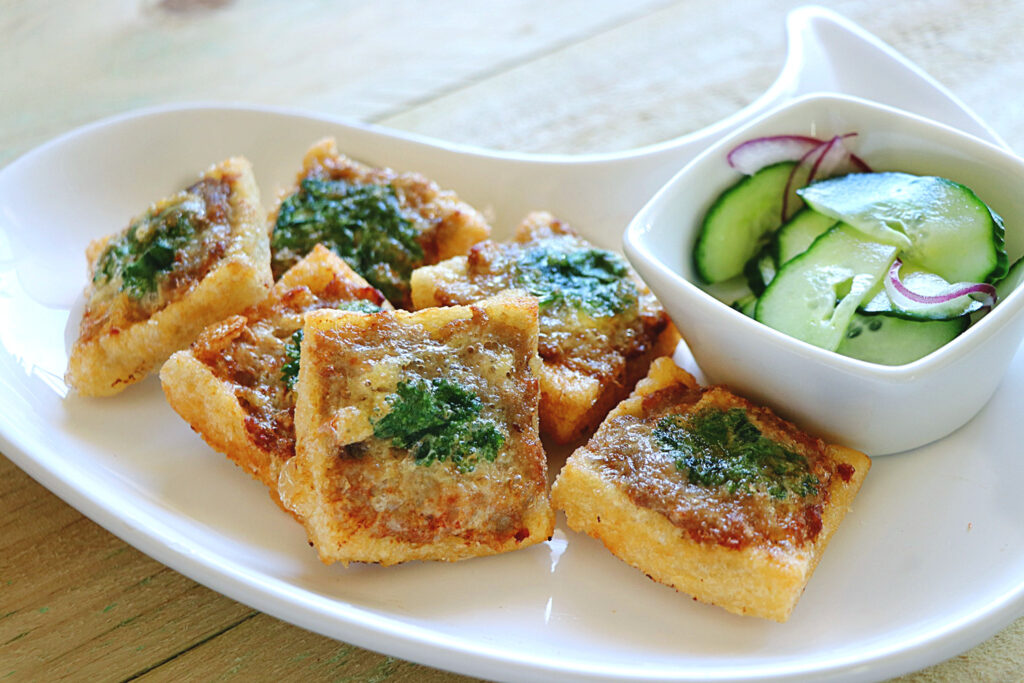
Ingredients for Khanom Pang Na Moo
Instructions for Khanom Pang Na Moo
Prepare the Pork Mixture: In a mixing bowl, combine the minced pork with minced garlic, soy sauce, sugar, white pepper, and chopped coriander. Mix well until the ingredients are thoroughly combined and the mixture is slightly sticky.
Spread on Bread: Lay the bread slices on a flat surface and spread the pork mixture evenly over one side of each bread slice, covering the surface completely.
Dip in Egg: Heat the oil in a deep frying pan over medium heat. While the oil is heating, dip each bread slice, pork side down, into the beaten eggs, ensuring the pork mixture is lightly coated with egg.
Fry the Pork Toast: Carefully place the bread slices, pork side down, into the hot oil. Fry until the pork side is golden brown and crispy, then flip to lightly brown the bread side. This should take about 3-4 minutes per side.
Serve: Remove the pork toast from the oil and drain on paper towels to remove excess oil. Cut each slice into triangles or quarters and serve hot with sweet chili sauce for dipping. Enjoy the crispy texture and savory flavors as a delightful starter or snack.
Som Tum(Green Papaya Salad)
Som Tum, or Green Papaya Salad, is a quintessential Thai dish celebrated for its invigorating blend of flavors and textures. This salad features thinly shredded green papaya as its base, mixed with carrots, tomatoes, and long beans.
It’s dressed in a zesty concoction of lime juice, fish sauce, garlic, and chilies, creating a perfect balance of sour, salty, and spicy. Crushed peanuts and dried shrimp add a crunchy texture, while palm sugar rounds out the flavors with a touch of sweetness.
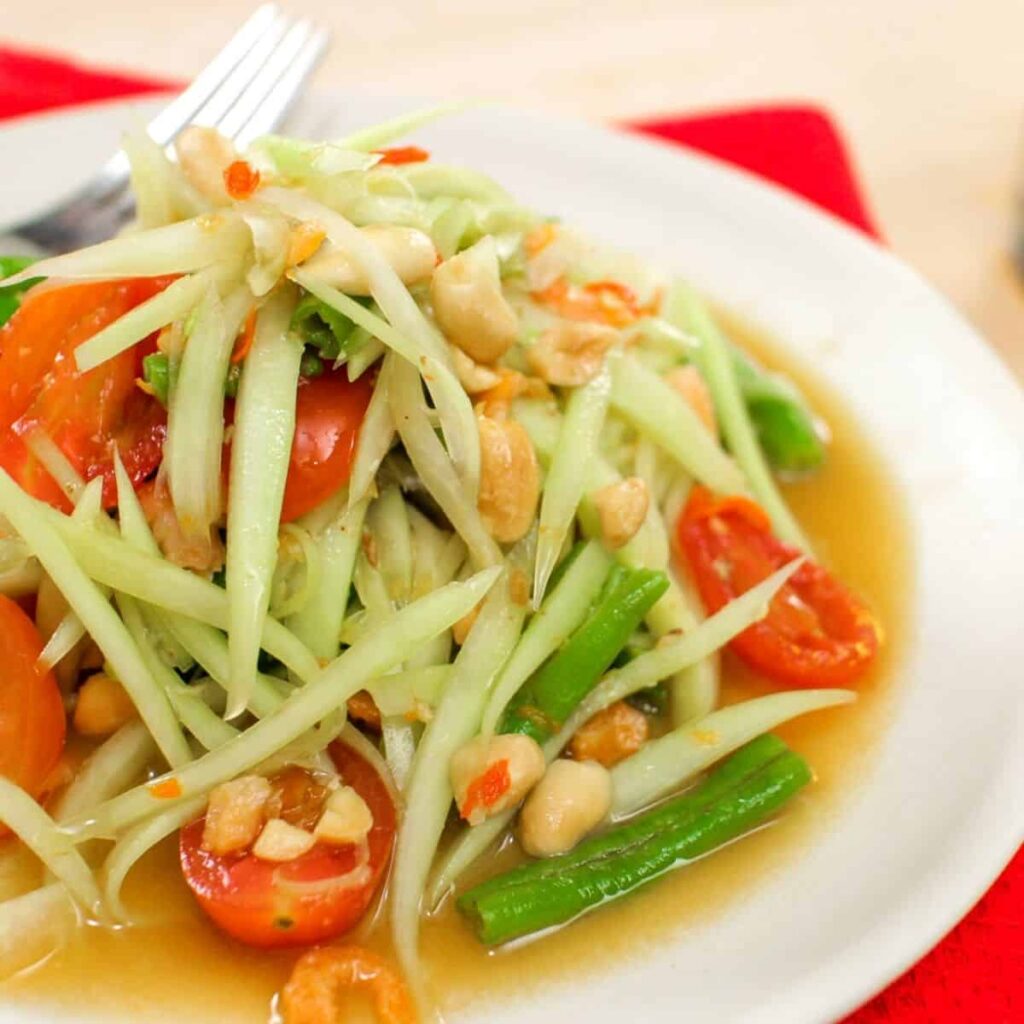
Ingredients for Som Tum
Instructions for Som Tum
Prepare the Ingredients: Begin by peeling and shredding the green papaya and carrot into thin strips using a julienne peeler or a sharp knife. Set aside in a large mixing bowl. Cut the tomatoes into wedges and the long beans into manageable pieces.
Crush the Flavor Base: In a mortar and pestle, crush the garlic and chilies together until you form a rough paste. This releases the oils and flavors, which are essential for the dressing.
Mix the Dressing: To the garlic and chili paste, add fish sauce, lime juice, and palm sugar. Mix until the sugar dissolves completely, creating a harmonious blend of sweet, tangy, and savory flavors.
Combine the Salad: Add the shredded papaya, carrot, tomatoes, and long beans to the mortar (or transfer everything to a larger bowl if needed). Pound lightly with the pestle, mixing with a spoon to combine the vegetables with the dressing. The goal is to slightly bruise the vegetables to absorb the flavors without mashing them.
Add Final Touches: Stir in the crushed peanuts and dried shrimp (if using), mixing well to distribute them throughout the salad.
Serve Fresh: Serve the salad immediately to enjoy its crisp texture and vibrant flavors. Som Tum is best enjoyed fresh as a light meal or as a side dish with grilled meats and sticky rice.
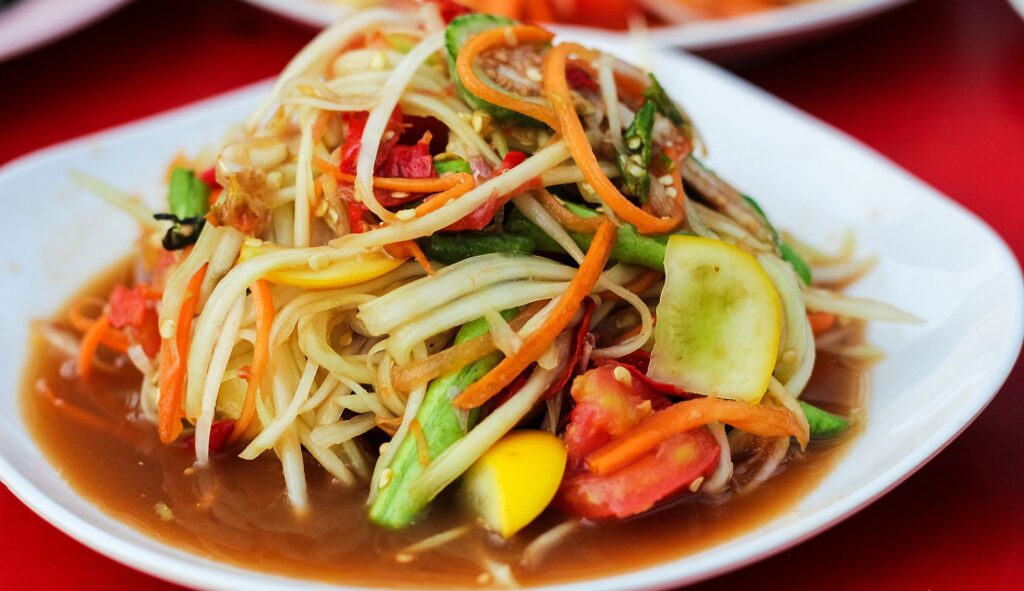
Health Benefits of Thai Foods
Rich in Nutritious Ingredients: Thai dishes frequently incorporate a variety of fresh vegetables, lean meats, and seafood, which are excellent sources of essential nutrients such as protein, fiber, vitamins, and minerals. Ingredients like ginger, turmeric, and garlic, which are staples in many recipes, offer anti-inflammatory and antioxidant properties.
Promotes Digestive Health: The use of fresh herbs and spices like lemongrass, galangal, and chili peppers not only enhances the flavor of the food but also aids digestion. These elements help stimulate the digestive system, reduce bloating, and promote regularity.
Heart Health: Many Thai dishes are prepared with ingredients that are beneficial for heart health. For instance, the frequent use of fish provides omega-3 fatty acids, which are known to improve heart health by reducing triglycerides and lowering blood pressure.
Weight Management: Thai food often features a balance of lean proteins and vegetables, combined with the flavorful use of herbs and spices, which can help in managing weight. The high spice content in some dishes also increases metabolism, aiding in weight loss.
Immune System Boost: Ingredients such as chili peppers, which are rich in vitamin C, and other antioxidants present in Thai cuisine, help strengthen the immune system. This is crucial for fighting off infections and maintaining overall health.
Overall, Thai food offers a delicious way to enjoy a diet that supports long-term health and well-being, provided it is prepared with fresh ingredients and consumed in moderation.
Tips and Tricks

What Can Be Serve With Thai Appetizers?
Can Thai Appetizers Be Made Ahead Of Time?
Yes, many Thai appetizers can be made ahead of time, which is great for planning parties or events. Here are a few tips on how to prepare and store them.
Preparing these appetizers ahead of time can save you effort and stress, especially when hosting. Just remember to handle the final preparations or cooking close to the time of serving to ensure the best flavor and texture.
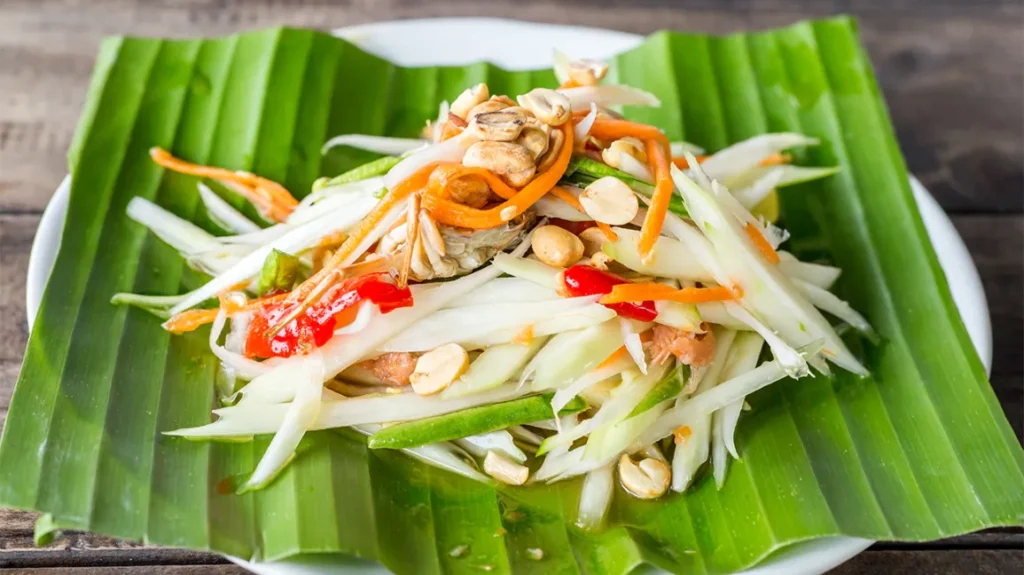
Storage And Reheating
Storage Tips
Reheating Tips
Suggested Yummy Meals
Perfect Turkey Bolognese Recipe
Flavorful And Delicious Chicken Shawarma Bowl Recipe
Frequently Asked Questions – FAQ’s
Conclusion
The Chicken Shawarma Bowl is a vibrant and versatile dish that brings the exotic flavors of the Middle East right to your table. With its succulent, spice-marinated chicken paired with a medley of fresh, crisp vegetables and creamy sauces, it offers a delightful balance of textures and flavors. This dish is not only delicious but also customizable, allowing you to cater to various dietary preferences and spice levels.
Whether served over a bed of fluffy rice or crisp greens, the Chicken Shawarma Bowl is a satisfying meal that promises a culinary adventure in each bite. It’s perfect for a family dinner, a casual get-together, or even as a nutritious meal prep option for the week.



